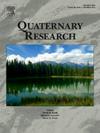美国佛蒙特州全新世花粉气候重建
IF 1.8
3区 地球科学
Q3 GEOGRAPHY, PHYSICAL
引用次数: 0
摘要
来自佛蒙特州Twin Ponds的13.0卡BP花粉记录为美国东北部的气候历史提供了新的见解。现代类似物被用于对双池塘进行定性和定量的气候重建。Twin Ponds的记录与附近的Knob Hill Pond进行了比较,以开发佛蒙特州的重建项目,并与纬度相似的两个地点的重建项目进行了比较。冰川后升温11.5卡BP,这是有记录以来最大的温度变化。最温暖、最干燥的条件出现在约9.0卡BP,随后湿度增加。现代类似物的位置从5.7到4.0卡BP的纬度和海拔变化被用来推断在加拿大松衰退期间的冷却和湿度增加。对佛蒙特州两个地点之间花粉事件发生时间的分析表明,在更北部的Knob Hill池塘,加拿大T.canadensis的数量下降得更快,并进一步支持了较冷的温度导致这一事件的可能性。其他北部地区显示出类似的趋势,直到2.5卡BP,最东部地区的降水量出现分化,表明现代气候梯度的建立。本文章由计算机程序翻译,如有差异,请以英文原文为准。
A Holocene pollen-inferred climate reconstruction for Vermont, USA
A 13.0 cal ka BP pollen record from Twin Ponds, Vermont, provides new insights into the climate history of the northeastern United States. Modern analogs were used to produce qualitative and quantitative climate reconstructions for Twin Ponds. The Twin Ponds record was compared with nearby Knob Hill Pond to develop a Vermont reconstruction that was compared with reconstructions from two sites at a similar latitude. Postglacial warming at 11.5 cal ka BP followed a cool, wet Younger Dryas and was the largest temperature change of the record. The warmest, driest conditions occurred at ca. 9.0 cal ka BP, followed by an increase in moisture. Latitudinal and elevational shifts in the location of modern analogs from 5.7 to 4.0 cal ka BP were used to infer cooling and increased moisture during the Tsuga canadensis decline. Analysis of the timing of pollen events between the two Vermont sites suggests a more rapid decline in T. canadensis at the more northern Knob Hill Pond and further supports the possibility that colder temperatures contributed to this event. The other northern sites show similar trends until 2.5 cal ka BP, when precipitation in the easternmost site diverges, indicating the establishment of modern climatic gradients.
求助全文
通过发布文献求助,成功后即可免费获取论文全文。
去求助
来源期刊

Quaternary Research
地学-地球科学综合
CiteScore
4.70
自引率
8.70%
发文量
57
审稿时长
3 months
期刊介绍:
Quaternary Research is an international journal devoted to the advancement of the interdisciplinary understanding of the Quaternary Period. We aim to publish articles of broad interest with relevance to more than one discipline, and that constitute a significant new contribution to Quaternary science. The journal’s scope is global, building on its nearly 50-year history in advancing the understanding of earth and human history through interdisciplinary study of the last 2.6 million years.
 求助内容:
求助内容: 应助结果提醒方式:
应助结果提醒方式:


